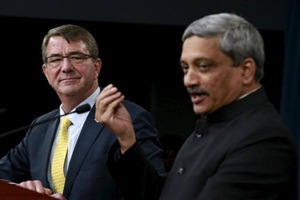In a landmark move, India and US are inching towards a logistics exchange agreement to enable both militaries to use each other’s assets and bases for repair and replenishment of supplies. The move assumes importance as both sides seek to counter the growing maritime assertiveness of China.
While a formal logistics agreement is yet to be signed, progress was made during US Defence Secretary Ashton Carter’s India visit, when the two countries agreed “in principle” on the pact. Carter said the two sides would finalise the text of an agreement in coming weeks.
Why is this logistics agreement important? What does it mean for both India and US, in context to regional dynamics? We take a look:
1. Defence Minister Manohar Parrikar has said, “As our (India-US) engagement deepens, we need to develop practical mechanisms to facilitate such exchanges. In this context, Secretary Carter and I agreed in principle to conclude a Logistics Exchange Memorandum of Agreement (LEMOA) in the coming months.”
LEMOA is a tweaked version of LSA which facilitates the provision of logistical support, supplies and services between the US military and the armed forces of partner countries on a reimbursable basis, and provides a framework that governs the exchange of logistics support, supplies and services.
2. Explaining the proposed agreement, Parrikar said it is for providing logistics whenever they need fuel or other support during operations like the humanitarian exercise done in wake of the devastating earthquake in Nepal.
“This will help if any such situation comes up. Logistics is a very important part of the operation. It will be on case by case basis,” Carter said, adding that “all issues” relating to the deal have been resolved.
3. Parrikar and Carter made it clear that the agreement does not entail deployment of American troops on Indian soil.
4. India was earlier of the view that a logistics agreement would be seen as a military alliance with the US. However, with a tweaked LSA, India will decide on a case-to-case basis. LSA was part of the three controversial agreements that the US has been pursuing India to sign for nearly a decade.
Termed as the “foundational agreements”, the other two are — Communications and Information Security Memorandum of Agreement (CISMOA) and Basic Exchange and Cooperation Agreement (BECA).
5. US has been urging India to sign an LSA that allows the two militaries to use each other’s land, air and naval bases for resupplies, repair and rest. India has had concerns that a logistics agreement would draw it into a military alliance with the United States and undermine its traditional autonomy.
6. PM Narendra Modi’s administration, faced with an assertive China expanding its influence in the South China Sea and into the Indian Ocean, has signalled its desire to draw closer to the United States.
7. US officials said the logistics agreement will help the two militaries coordinate better, including in exercises, and also allow each other to more easily sell fuel or provide spare parts to India.
8. The US military has made clear it wants to do more with India, especially in countering China. Carter is on his second visit to India in less than a year, aimed at cementing defence cooperation in the final months of Barack Obama’s presidency.
(With inputs from Reuters & PTI)
